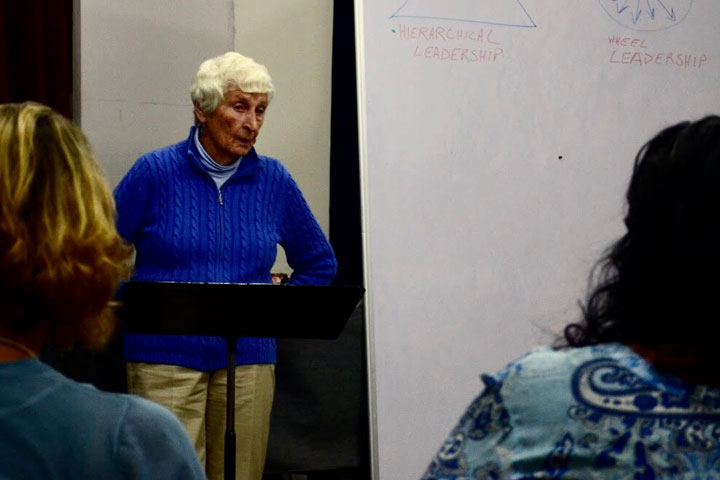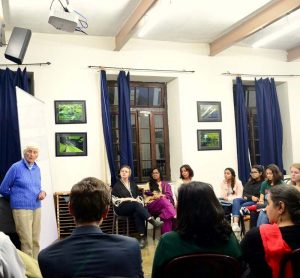
01 Sep On leadership
Inspired by a talk from our resident scholar, Dr Eleanor Nicholson, student and Centre for Imagination Intern Shatakshi Kabi gives her perspective on leadership at Woodstock.
 Walking around the hallways of Woodstock, carrying the weight of our subjects on our backs and scheduling our surging homework in our heads, we as students, are constantly leading our own lives every day. We’re on a persistent voyage of organising, planning and making our own choices to steer our lives in the direction we want to sail. But, in the midst of being our own leaders, how do we as individuals make an effort to simultaneously lead the people around us to create a collective benefit?
Walking around the hallways of Woodstock, carrying the weight of our subjects on our backs and scheduling our surging homework in our heads, we as students, are constantly leading our own lives every day. We’re on a persistent voyage of organising, planning and making our own choices to steer our lives in the direction we want to sail. But, in the midst of being our own leaders, how do we as individuals make an effort to simultaneously lead the people around us to create a collective benefit?
Embracing individual responsibility
Just last week, one of our visiting scholars, Dr Eleanor Nicholson, gave an insightful talk about the role of leadership at Woodstock and in the world. This was followed by a riveting discussion led by staff and students along similar lines. Through what she has gauged during the short span of time she’s spent at Woodstock (this time around; Dr Nicholson has also served as Woodstock’s interim Principal and Board Chairman for three years), she expressed, “Many students here at Woodstock school have observed and absorbed the ethos of individual responsibility, some to an amazing extent of maturity, especially when we consider the tumultuous years of adolescence they’re passing through. In my short stay so far, I see collegiality, independence, and initiative; in other words, professionalism. I sense that there are doors here that open to new ports, ideas, and suggestions. They’re visible on campus through the interaction between students and staff.”

"If you sit in any classroom and just observe, you’ll see the spark of leadership present in the room in some way as students raise their hands, speak their opinions, or even in their ability to simply listen to others."
If one takes a stroll around the school library, living examples of this statement will be seen, engrossed in concentration as much as in their laptops and math notebooks, already taking responsibility for their own work. Even if you sit in any classroom and just observe, you’ll see the spark of leadership present in the room in some way as students raise their hands, speak their opinions, or even in their ability to simply listen to others.
Equality in leadership
Dr Nicholson also expanded on this subject by gearing it towards women in leadership at Woodstock by throwing light upon the fact that the proportion of women leading departments here are evidently less compared to the men. Yet, she continued, this unevenness does not seem to be a hindrance for this school to achieving its mission of ‘eliciting greatness’. But, these uneven numbers sprouted a prolonged interest for discussion, which kicked off with a question asked by a student: “Do we have more female students in Woodstock than male students?” This question triggered more responses from the students who included that they felt as if the proportion of female teachers reduced as students progressed up through their grade levels. It’s strangely evident that almost all math teachers, especially, are males; that is not only in Woodstock but in most schools all around the world. Leadership for certain jobs has been categorised so much on the basis of gender that it has originated stereotypical judgment when it comes to working.
 As further expressed by the students during the discussion, one factor that may restrict some students from initiating leadership roles in anything from class discussion to running for the Student Council positions could be their gender. Two of the students agreed that being outnumbered by boys in their class somehow holds them back from participating more in class discussions because they seem to be more dominating and intimidating. In addition to that, two other students felt that a person’s popularity in school is another factor which affects the kind of leadership roles they manage to earn or take an initiative to be a part of. These are definitely significant factors which are pretty common in various high schools when it comes to students in relation to their leadership qualities. Being a leader does not necessarily have to mean that one needs to have people following them.
As further expressed by the students during the discussion, one factor that may restrict some students from initiating leadership roles in anything from class discussion to running for the Student Council positions could be their gender. Two of the students agreed that being outnumbered by boys in their class somehow holds them back from participating more in class discussions because they seem to be more dominating and intimidating. In addition to that, two other students felt that a person’s popularity in school is another factor which affects the kind of leadership roles they manage to earn or take an initiative to be a part of. These are definitely significant factors which are pretty common in various high schools when it comes to students in relation to their leadership qualities. Being a leader does not necessarily have to mean that one needs to have people following them.
In my view, an organisation has a true leader if its success doesn’t revolve around the leader’s excellence but the organisation’s ability to function as successfully even when the leader moves on.
Words: Shatakshi Kabi, Woodstock student and Centre for Imagination Intern
Photography: Palden Gonsar, Woodstock student and Centre for Imagination Intern






No Comments